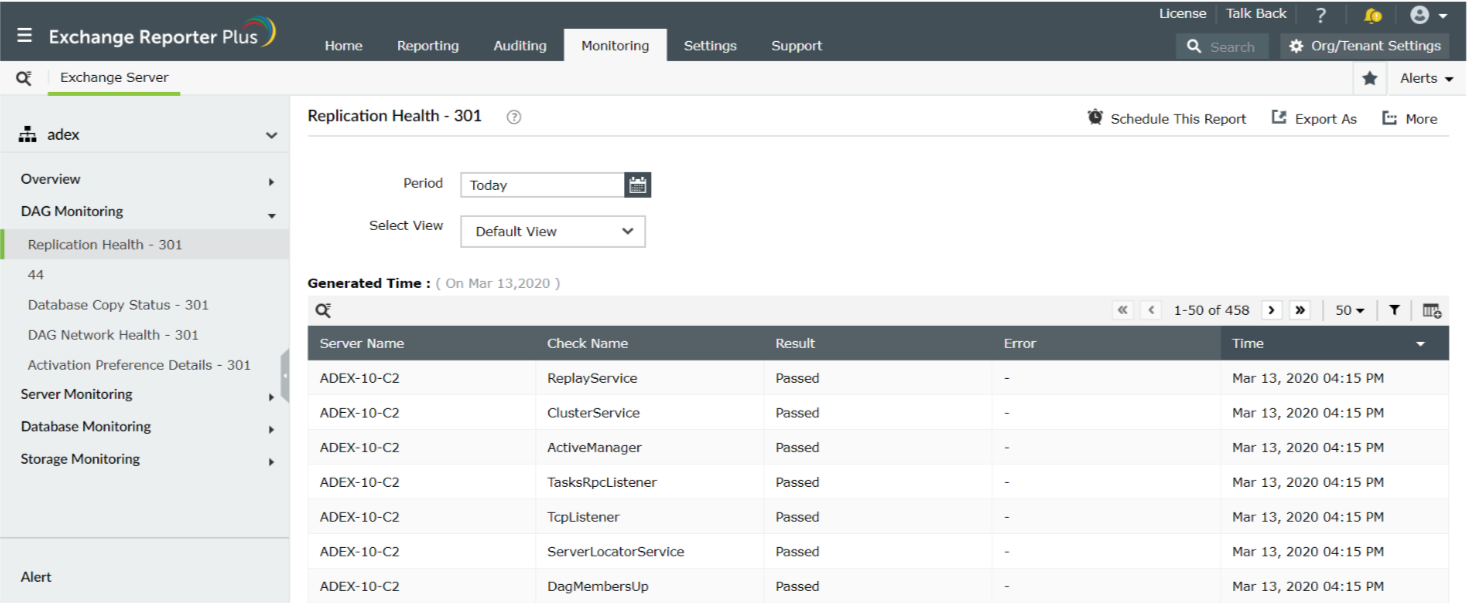The Test-ReplicationHealth cmdlet is used to monitor the mailbox replication process. In environments with database availability groups (DAGs), you can use this cmdlet to track failures in the replication process and mend them at the earliest.
How to use the Test-ReplicationHealth cmdlet:
Format:
Test-ReplicationHealth [[-Identity] <ServerIdParameter>] [-ActiveDirectoryTimeout <Int32>] [-Confirm] [-DomainController <Fqdn>] [-MonitoringContext <Boolean>] [-OutputObjects] [-TransientEventSuppressionWindow <UInt32>] [-WhatIf] [-DatabaseAvailabilityGroup <DatabaseAvailabilityGroupIdParameter>] [<CommonParameters>]
Eg. Test-ReplicationHealth -Identity ExchSer1
This cmdlet can be used to monitor and verify the status of replication of a specific mailbox server (here in this case ExchSer1) in the configured DAG.
What if you have to check the replication status of hundreds of mailbox servers every day? That's where you need Exchange Reporter Plus, an Exchange reporting, change auditing and monitoring tool. This solution provides easy-to-generate, intuitive reports and most importantly helps save a lot of productive time that goes into tedious scripting.
Steps to monitor replication health using Exchange Reporter Plus:
- Go to the Monitoring tab on the top pane.
- Navigate to DAG Monitoring on left side.
- From the drop-down choose Replication Health report.
- Enter the period for report generation.
- Select the type of view in which you want the report to be presented. (Summary, default or custom view).

The Exchange Reporter Plus exclusives:
- Report Scheduling: Schedule reports to generate them automatically and send them to concerned authorities such as IT admins and managers through email.
- Quick access and export options: Add reports as favourites to access them easily and export reports to different file formats such as PDF, HTML, XLS and CSV.
- Filter and alerting options: Add or remove columns from the report generated to view information relevant to your needs. Use advanced filters options available to customize your search and configure alert profiles for specific actions to get real-time updates.
- Technician Delegation: Delegate different reports to different technicians. Have control over who gets access to what. You can also protect your reports with passwords.
- Easy-to-analyse reports: Generate reports on periodic basis, per domain basis, tenant-wise or get an overall summary as you choose. Get graphical and dashboard representation of complex analytical data.
- Log Forwarding to SIEM solutions: Integrate with other SIEM solutions such as splunk and syslog and forward logs to them for analytical purposes.
Click here to learn about how you can effectively monitor your Exchange Server using Exchange Reporter Plus.